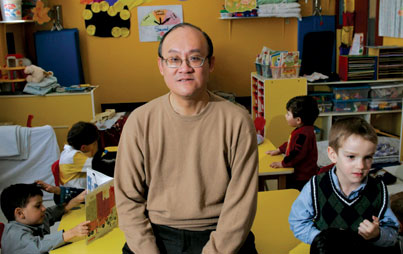By Jadzia Jagiellowicz
Pioneering reproductive technologies give hope to women facing infertility

McGill researchers are helping women turn back their biological clocks – or at least set them to daylight savings time.
Researchers at the McGill Reproductive Centre (MRC) of the McGill University Health Centre have patented a technique that allows women to save their healthy eggs for later fertilization and implantation.
MRC Medical Director Seang Lin Tan, Scientific Director Ri-Cheng Chian and their colleagues have developed a specialized process to rapidly freeze the egg. The process, called vitrification, ensures there is no ice-crystal build-up and consequent damage, a problem that has plagued other methods of egg preservation.
The process offers new hope to women in their mid-30s, an age at which the success rate for pregnancy drops dramatically. In April 2005, the centre achieved the first Canadian birth using frozen eggs.
“We are hopeful we have shifted the odds back into the woman’s favour,” says Tan. “Now, women in their mid-30s who have previously frozen their eggs should have the same chance of pregnancy as when they were in their early 20s, because the eggs will be young.”
The MRC also offers new hope of motherhood to young women undergoing cancer therapy – which can cause infertility and premature menopause – by freezing their eggs prior to chemotherapy, for use once these women are well.
To date, seven out of 15 women who have had previously frozen eggs transferred have become pregnant.
Egg freezing is one of several assisted reproductive technologies that the centre offers patients to improve fertility.
Best-known is in-vitro fertilization (IVF), the technology that resulted in the birth of the first test-tube baby in 1978. Conventional IVF involves giving a woman a follicle-stimulating hormone to increase the number of mature eggs. The eggs are then collected, fertilized and grown for two to three days outside the womb. The resulting embryos are transferred to the woman’s uterus.
But conventional IVF has a potential risk that the hormones will induce ovarian hyperstimulation syndrome, a painful – and in rare cases life-threatening – side effect. The McGill Reproductive Centre is one of the few facilities in North America using in-vitro maturation or IVM, a new technique that eliminates ovarian hyperstimulation syndrome.
IVM involves collecting immature eggs from the ovaries and maturing them in a specially formulated liquid outside the womb for up to 48 hours. Unlike conventional IVF, the technique uses no exogenous follicle-stimulating hormone. One sperm is injected into each matured egg, increasing the chances of fertilization. The new embryos are then transferred to the uterus or frozen for future use.
“At 35 to 40 per cent, our pregnancy rates for IVM are probably the highest in the world,” says a proud Tan, whose many accomplishments are best measured by the number of newborn babies and the smiles of their happy parents.
History of Assisted Reproductive Technologies
1978 First IVF (in-vitro fertilization) baby born – England
1984 First baby born from frozen embryo – Australia
1991 First baby born from in-vitro matured eggs using donated eggs – South Korea
1992 Pre-implantation genetic diagnosis developed in England
1992 Single sperm injection technique developed in Belgium
1994 First baby born from in-vitro matured eggs using the patient’s own eggs – Australia
1998 McGill Reproductive Centre begins research on egg freezing
1999 McGill Reproductive Centre offers IVM (in-vitro maturation) treatment
2005 McGill Reproductive Centre announces birth of first baby in Canada conceived though use of frozen egg
